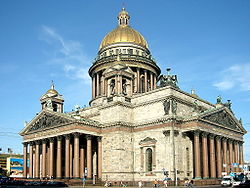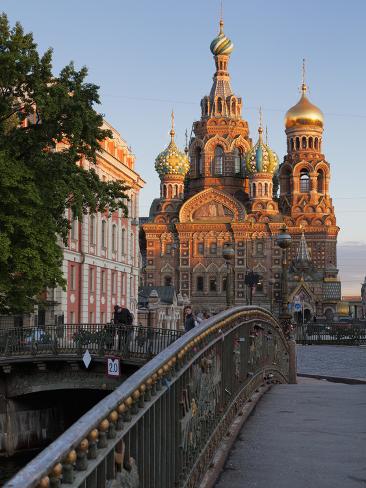RUSSIA | DISCOVER RUSSIA | St. Petersburg
Destination St. Petersburg

The Historic Centre of Saint Petersburg and Related Groups of Monuments constitute a UNESCO World Heritage Site. Saint Petersburg is also home to The Hermitage, the largest art museum in the world. Russia's political and cultural centre for 200 years, the city is sometimes referred to in Russia as the Northern Capital.
• Discover St. Petersburg At-a-Glance
Admiralty Shipyard

The Admiralty Shipyard (Admiralty Wharves) (formerly Soviet Shipyard No. 194) is one of the oldest and largest shipyards in Russia, located in Saint Petersburg. The shipyard's building ways can accommodate ships of up to 70,000 metric tons deadweight (DWT), 250 meters in length and 35 meters in width. Military products include naval warships such as nuclear and diesel-powered submarines and large auxiliaries. …
Alexander Column

The Alexander Column, also known as Alexandrian Column, is the focal point of Palace Square in Saint Petersburg, Russia. The monument was erected after the Russian victory in the war with Napoleon's France. The column is named for Emperor Alexander I of Russia, who reigned from 1801–25. The column is a single piece of red granite, 25.45 m (83 ft 6 in) long and about 3.5 m (11 ft 5 in) in diameter …
Bolsheokhtinsky Bridge

Bolsheokhtinsky Bridge is a bridge across the Neva River in Saint Petersburg, Russia. The bridge's length is 334 meters, the width is 23 meters. The bridge features only three spans, the central one can be drawn. The initial idea to build a bridge near the Okhta river was circulated in 1829. Even before the Saint Petersburg was founded, there were settlements in the Okhta region, and with the growth of the city, it quickly grew to become big industrial center …
Bronze Horseman

The Bronze Horseman is an equestrian statue of Peter the Great in Saint Petersburg, Russia. Commissioned by Catherine the Great, it was created by the French sculptor Étienne Maurice Falconet. It is also the name of a narrative poem written by Aleksander Pushkin about the statue in 1833, widely considered to be one of the most significant works of Russian literature. The statue came to be known as the Bronze Horseman because of the poem's great influence and success …
Catherine Palace

The Catherine Palace is a Rococo palace located in the town of Tsarskoye Selo (Pushkin), 25 km southeast of St. Petersburg, Russia. It was the summer residence of the Russian tsars. The residence originated in 1717, when Catherine I of Russia engaged the German architect Johann-Friedrich Braunstein to construct a summer palace for her pleasure. In 1733, Empress Anna commissioned Mikhail Zemtsov and Andrei Kvasov to expand the Catherine Palace …
Church of the Saviour on Spilled Blood

The Church of the Savior on Spilled Blood is one of the main sights of St. Petersburg, Russia. It is also variously called the Church on Spilt Blood and the Cathedral of the Resurrection of Christ, its official name. This Church was built on the site where Tsar Alexander II was assassinated and was dedicated in his memory …
Hermitage Museum

The State Hermitage is a museum of art and culture in Saint Petersburg, Russia. One of the largest and oldest museums in the world, it was founded in 1764 by Catherine the Great and has been open to the public since 1852. Its collections, of which only a small part is on permanent display, comprise over three million items, including the largest collection of paintings in the world. The collections occupy a large complex of six historic buildings along Palace Embankment, including the Winter Palace …
Kazan Cathedral

Kazan Cathedral or Kazanskiy Kafedralniy Sobor, also known as the Cathedral of Our Lady of Kazan, is a cathedral of the Russian Orthodox Church on the Nevsky Prospekt in St. Petersburg. It is dedicated to Our Lady of Kazan, probably the most venerated icon in Russia. The construction was started in 1801 and continued for ten years. Upon its completion the new temple replaced the Church of Nativity of the Theotokos, which was disassembled when the Kazan Cathedral was consecrated …
Mariinsky Palace

Mariinsky Palace, also known as Marie Palace), was the last Neoclassical imperial palace to be constructed in Saint Petersburg, Russia. It was built between 1839 and 1844 to a design by the court architect Andrei Stackensneider. The palace stands on the south side of St Isaac's Square, just across the 99-metre-wide Blue Bridge from Saint Isaac's Cathedral. In the 18th century, the plot belonged to Zakhar Tchernyshov and contained his mansion (1762-68), which was occasionally let to Prince of Condé and other foreign worthies visiting the Russian capital …
Neva River

The Neva is a river in northwestern Russia flowing from Lake Ladoga through the western part of Leningrad Oblast (historical region of Ingria) to the Neva Bay of the Gulf of Finland. Despite its modest length (74 km), it is the third largest river in Europe in terms of average discharge (after the Volga and the Danube). The Neva is the only river flowing from Lake Ladoga. It flows through the city Saint Petersburg, three smaller towns of Shlisselburg, Kirovsk and Otradnoye, and dozens of settlements …
Nevsky Prospekt

Nevsky Avenue is the main street in the city of St. Petersburg, Russia. Planned by Peter the Great as beginning of the road to Novgorod and Moscow, the avenue runs from the Admiralty to the Moscow Railway Station and, after making a turn at Vosstaniya Square, to the Alexander Nevsky Lavra. The chief sights include the Rastrelliesque Stroganov Palace, the huge neoclassical Kazan Cathedral, the Art Nouveau Bookhouse, Elisseeff Emporium, half a dozen 18th-century churches, a monument to Catherine the Great …
New Holland Island

New Holland Island in Saint Petersburg was created in 1720, when the newly built Kryukov Canal and Admiralty Canal connected the Moika River with the Neva. The triangular island took its name after a number of canals and shipbuilding facilities that rendered its appearance similar to Amsterdam. During the following centuries, the island belonged to the Russian Admiralty, which would adapt the plot for its various needs. Originally, there was a minor shipyard for rowing boats …
Palace Square

Palace Square, connecting Nevsky Prospekt with Palace Bridge leading to Vasilievsky Island, is the central city square of St Petersburg and of the former Russian Empire. It was the setting of many events of worldwide significance, including the Bloody Sunday (1905) and the October Revolution of 1917. The earliest and most celebrated building on the square is the baroque white-and-azure Winter Palace of Russian tsars (1754–62) …
Peter and Paul Fortress

The Neva is a river in northwestern Russia flowing from Lake Ladoga through the western part of Leningrad Oblast (historical region of Ingria) to the Neva Bay of the Gulf of Finland. Despite its modest length (74 km), it is the third largest river in Europe in terms of average discharge (after the Volga and the Danube). The Neva is the only river flowing from Lake Ladoga. It flows through the city Saint Petersburg, three smaller towns of Shlisselburg, Kirovsk and Otradnoye, and dozens of settlements …
Peterhof

Petergof or Peterhof (Dutch/German for "Peter's Court"), known as Petrodvorets from 1944 to 1997, is a municipal town in Petrodvortsovy District of the federal city of St. Petersburg, located on the southern shore of the Gulf of Finland. The town hosts one of two campuses of Saint Petersburg State University and the Petrodvorets Watch Factory, one of the leading Russian watch manufactures. A series of palaces and gardens, laid out on the orders of Peter the Great, and sometimes called the "Russian Versailles", is also situated there …
Saint Isaac's Cathedral

Saint Isaac's Cathedral or Isaakievskiy Sobor in Saint Petersburg, Russia is the largest Russian Orthodox cathedral (sobor) in the city. It is dedicated to Saint Isaac of Dalmatia, a patron saint of Peter the Great, who had been born on the feast day of that saint. The church on St Isaac's Square was ordered by Tsar Alexander I, to replace an earlier Rinaldiesque structure, and was the fourth consecutive church standing at this place …
Winter Palace

The Winter Palace in Saint Petersburg, Russia, was, from 1732 to 1917, the official residence of the Russian monarchs. Situated between the Palace Embankment and the Palace Square, adjacent to the site of Peter the Great's original Winter Palace, the present and fourth Winter Palace was built and altered almost continuously between the late 1730s and 1837, when it was severely damaged by fire and immediately rebuilt …
Zayachy Island

Zayachy Island was for the most part swampy, unpopulated, and unremarkable until 1703, when Peter the Great began construction of the Peter and Paul fortress there, himself laying the foundation stones. Until the late 19th century, there were three canals inside the fortress, dividing the island into four parts. The canals were filled up by the late 19th century. The island is described as offering picturesque views of the city historical center and the Neva River …
RUSSIA | DISCOVER RUSSIA | St. Petersburg






